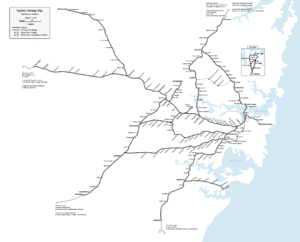CityRail
CityRail was a passenger railway brand operated by the State Rail Authority from 1989 to 2003 and by RailCorp from 2003 to 2013 with services in and around Sydney, Newcastle and Wollongong, the three largest cities in New South Wales, Australia.
In June 2013, it operated 307 stations and over 2,060 kilometres of track, extending north to the upper Hunter Valley, south to the Shoalhaven and Southern Highlands regions and west to Bathurst.
[1] CityRail was established pursuant to the Transport Administration Act, 1988 (NSW), and was first mentioned as an entity distinct from the State Rail Authority in the Parliament of New South Wales by then governor James Rowland on 21 February 1990.
[5] When the CityRail brand was introduced the State Rail Authority was part way through taking delivery of 450 Tangara carriages.
[17] EMU trainsets were identified by target plates, which are exhibited on the front lower nearside of driving carriages.
[19] According to the 2003 Parry Report, "The interaction of metropolitan, suburban, intercity and freight lines and services has resulted in an overly complex system.
[22] In October 2012, a report published by PricewaterhouseCoopers found CityRail performed poorly compared to many metro services from 27 other major world cities.
Expansions and contractions of the network and major events that affected the number of journeys made are included as notes.
:*Inbound Inner West and South services generally travelled around the City Circle in the clockwise direction.
Inbound Airport & East Hills and Bankstown services generally travelled around the City Circle in the anti-clockwise direction.
CityRail operated several bus routes along corridors where the railway line has been closed to passengers or as a supplement to rail services.
These lines stretched over 200 kilometres from Sydney, as far north as Newcastle, as far west as Bathurst, as far south-west as Goulburn and as far south as Kiama and Port Kembla.
Southern Highlands trains required a connection at Campbelltown as they ran into the city during peak hours only.
CBSM (Custom Built Sheet Metal) was responsible for the manufacture of many indicator board encasings.
The performance of the State Rail Authority and RailCorp were questioned in regards to safety, training, a politically motivated focus on punctuality, management and workplace culture, with strong criticism from Justice Peter McInerny in his inquiries into the accidents at Glenbrook and Waterfall.
CityRail has launched public information campaigns regarding railway trespassing, prams and strollers, and falling between the platform and the train.
[34] Crime committed on railway property has decreased by 32.9% since 2002, which RailCorp attributes to the deployment of some 600 Transit Officers across the network.
[35] All stations, including those that are remote or unstaffed, have emergency "help points" to put passengers in immediate contact with authorities should an incident occur.
[36] In 2008, overloading of trains was found by the Independent Pricing and Regulatory Tribunal (IPART)[37] to be a significant cause of delays.
A survey undertaken by RailCorp in September 2011 revealed that 6 of the 13 lines had a maximum load that exceeded 135% (of the seated capacity) during the peak morning commute.







